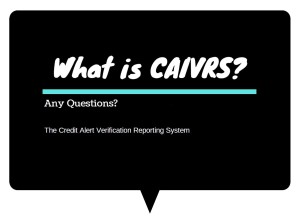 Credit Alert Verification Reporting System, commonly known as CAIVRS, is a shared database of Federal debtors. CAIVRS was developed in 1989 as a quick way for “processors of applications for Federal credit to identify people who are in default or have had claims paid on direct or guaranteed Federal loans, or are delinquent or have other debts owed to Federal agencies.” In the case of an applicant for a VA home loan, this means the lender is required to check the CAIVRS database to verify the potential borrower does not owe the Federal government money.
Credit Alert Verification Reporting System, commonly known as CAIVRS, is a shared database of Federal debtors. CAIVRS was developed in 1989 as a quick way for “processors of applications for Federal credit to identify people who are in default or have had claims paid on direct or guaranteed Federal loans, or are delinquent or have other debts owed to Federal agencies.” In the case of an applicant for a VA home loan, this means the lender is required to check the CAIVRS database to verify the potential borrower does not owe the Federal government money.
How Does CAIVRS Work?
The CAIVRS database has records on delinquent borrowers from several government agencies, including the Department of Housing and Urban Development (HUD) and the Department of Veterans Affairs (VA). Since a lender offering VA financing needs a “guarantee” from the VA, the lender is required to check CAIVRS. Most of the time there are no issues on the report. But if the applicant is reported to be delinquent or a claim was paid within the past three years, then the borrower will not be eligible for a new VA loan. At least not yet. There are three instances where the applicant may still be eligible.
- Loan Assumptions. If the VA borrower sold a previous property, with or without a release of liability, to someone who eventually defaulted on the government loan then the new applicant may be eligible if they can prove that the loan was not in default a the time of the home sale/loan assumption.
- Divorce. The applicant may be eligible if the divorce decree (or legal separation) awarded the property and responsibility for payment to the former spouse. However, if a claim was paid on a mortgage that was in default prior to the divorce then the applicant is not eligible.
- Bankruptcy. If the property was included in a bankruptcy that was caused by circumstances beyond the borrowers control, like death or big medical bills, then the borrower may be eligible if certain requirements are met. This exception can be a tough one but it is possible.
How do I “Clear CAIVRS”
Clearing CAIVRS can be a waiting game. For someone who lost a home with FHA or VA financing, a claim would have been paid from FHA or VA to the lender. But many times the lender doesn’t foreclose right away or doesn’t file the claim immediately. Especially in the past few years, with the abundance of foreclosures, some claims weren’t filed until months, or even years after the applicant lost their home. 3 years after the claim is paid the applicant can get a new VA or FHA loan. So it’s important to find out when the clock started ticking on that three years. Don’t assume it is three years after you lost the home.
A fast way to clear CAIVRS is to just pay back the amount owed to FHA or VA. Sometimes it can be a small amount and it may be worth it to just pay it off so that you can move forward with a new home purchase.
If you do have a debt owed on CAIVRS then your VA loan officer can give you a copy of the report. The report will show the agency reporting the default, the case number of the defaulted debt, the type of delinquency (default, claim, foreclosure, lien or judgment), and a telephone number top call for further information or assistance.
Authored by Tim Storm, a California Mortgage Loan Officer MLO 223456 – Please contact my office at the Emery Financial. Direct line at 949-640-3102. www.OrangeCountyVALoans.com
Google+